Housing Affordability in Australia: Strategic Planning and Solutions
VerifiedAdded on 2021/06/18
|9
|2033
|45
Report
AI Summary
This report provides an in-depth analysis of the housing affordability crisis in Australia, with a specific focus on Sydney. It investigates the factors contributing to high housing costs, including urbanization, immigration, and land scarcity. The report evaluates the effectiveness of strategic planning initiatives, such as the Greater Sydney Region Plan and the Western City District Plan, in addressing the affordability problem. It also explores how other cities, like Denver and London, are tackling similar challenges. The report concludes by highlighting the importance of strategic planning and government intervention to mitigate the housing affordability crisis and ensure accessible housing options for all residents, emphasizing the need for innovative solutions and collaborative efforts between government bodies and other stakeholders to address the evolving housing market. The study references various sources like Chappell, Daley, and others.

Running Header
Title :
Name:
Institution:
Title :
Name:
Institution:
Paraphrase This Document
Need a fresh take? Get an instant paraphrase of this document with our AI Paraphraser
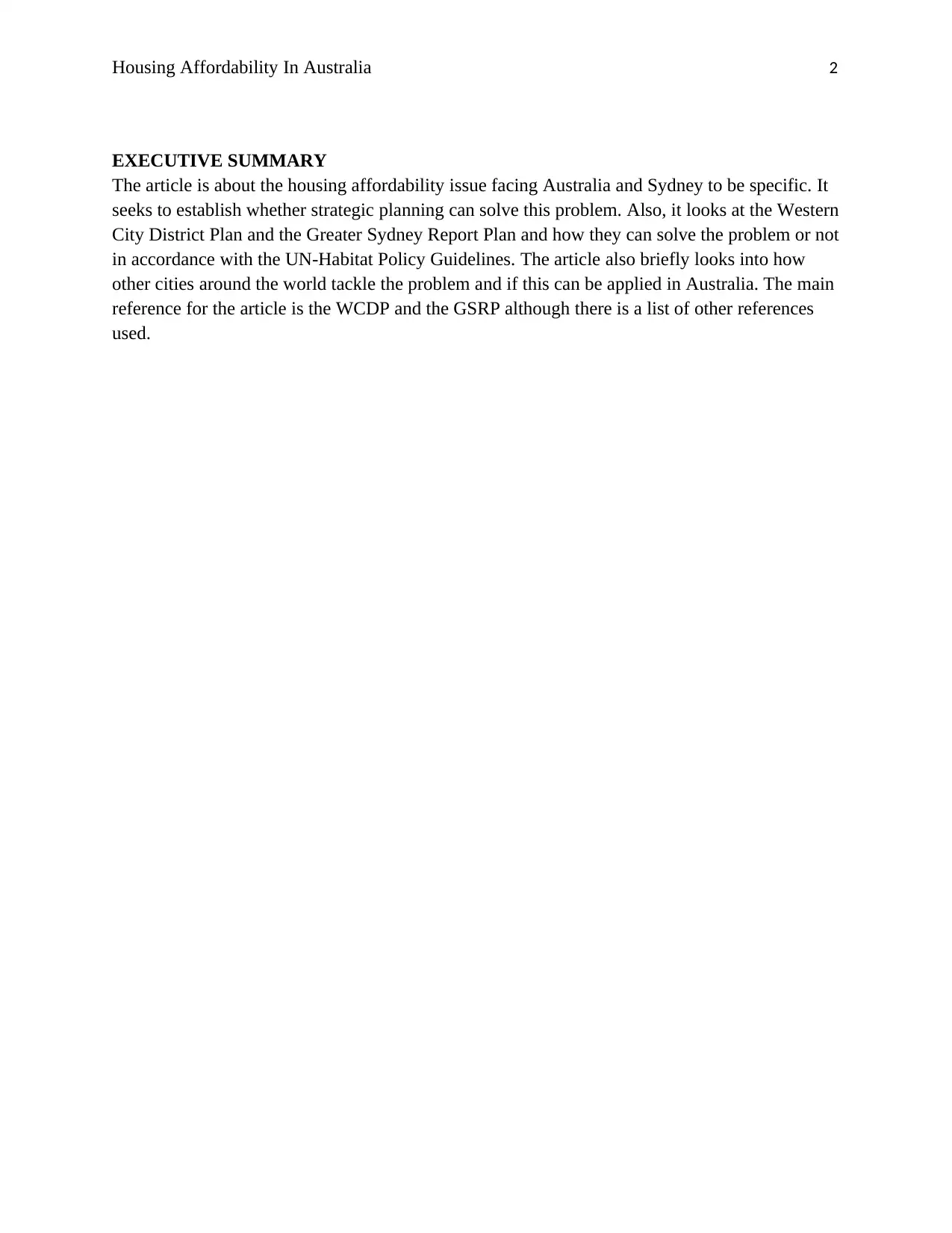
Housing Affordability In Australia 2
EXECUTIVE SUMMARY
The article is about the housing affordability issue facing Australia and Sydney to be specific. It
seeks to establish whether strategic planning can solve this problem. Also, it looks at the Western
City District Plan and the Greater Sydney Report Plan and how they can solve the problem or not
in accordance with the UN-Habitat Policy Guidelines. The article also briefly looks into how
other cities around the world tackle the problem and if this can be applied in Australia. The main
reference for the article is the WCDP and the GSRP although there is a list of other references
used.
EXECUTIVE SUMMARY
The article is about the housing affordability issue facing Australia and Sydney to be specific. It
seeks to establish whether strategic planning can solve this problem. Also, it looks at the Western
City District Plan and the Greater Sydney Report Plan and how they can solve the problem or not
in accordance with the UN-Habitat Policy Guidelines. The article also briefly looks into how
other cities around the world tackle the problem and if this can be applied in Australia. The main
reference for the article is the WCDP and the GSRP although there is a list of other references
used.
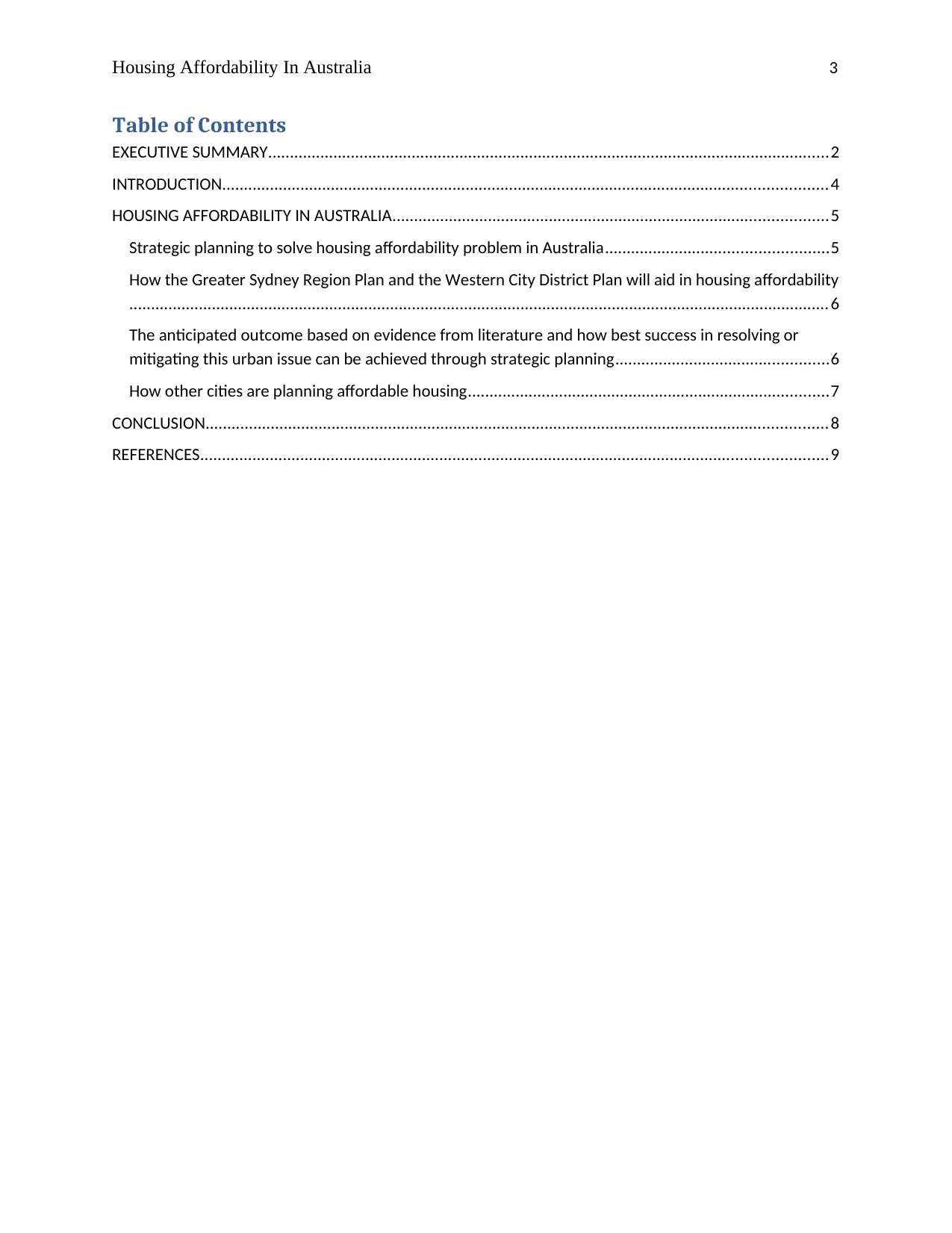
Housing Affordability In Australia 3
Table of Contents
EXECUTIVE SUMMARY.................................................................................................................................2
INTRODUCTION...........................................................................................................................................4
HOUSING AFFORDABILITY IN AUSTRALIA....................................................................................................5
Strategic planning to solve housing affordability problem in Australia...................................................5
How the Greater Sydney Region Plan and the Western City District Plan will aid in housing affordability
.................................................................................................................................................................6
The anticipated outcome based on evidence from literature and how best success in resolving or
mitigating this urban issue can be achieved through strategic planning.................................................6
How other cities are planning affordable housing...................................................................................7
CONCLUSION...............................................................................................................................................8
REFERENCES................................................................................................................................................9
Table of Contents
EXECUTIVE SUMMARY.................................................................................................................................2
INTRODUCTION...........................................................................................................................................4
HOUSING AFFORDABILITY IN AUSTRALIA....................................................................................................5
Strategic planning to solve housing affordability problem in Australia...................................................5
How the Greater Sydney Region Plan and the Western City District Plan will aid in housing affordability
.................................................................................................................................................................6
The anticipated outcome based on evidence from literature and how best success in resolving or
mitigating this urban issue can be achieved through strategic planning.................................................6
How other cities are planning affordable housing...................................................................................7
CONCLUSION...............................................................................................................................................8
REFERENCES................................................................................................................................................9
⊘ This is a preview!⊘
Do you want full access?
Subscribe today to unlock all pages.

Trusted by 1+ million students worldwide
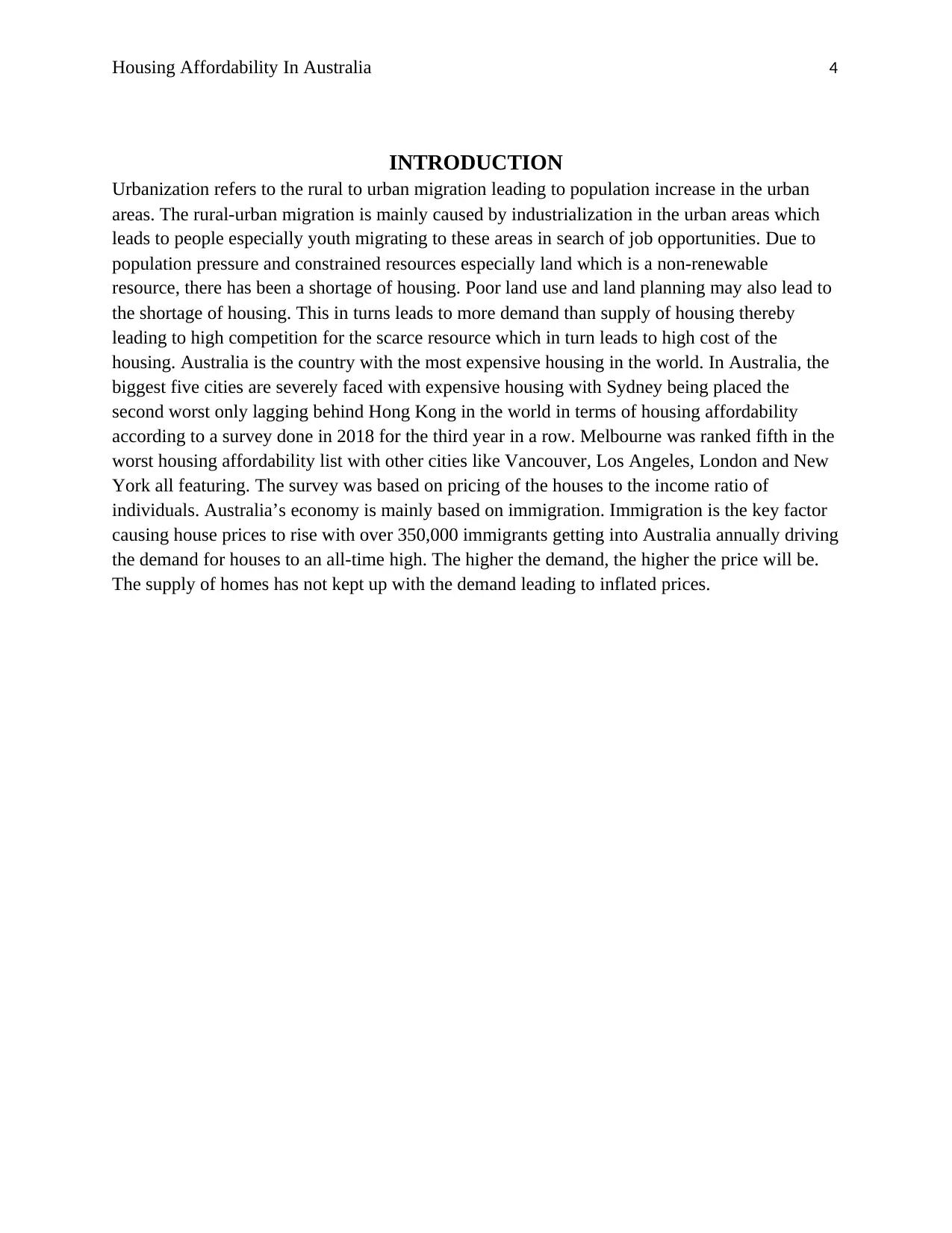
Housing Affordability In Australia 4
INTRODUCTION
Urbanization refers to the rural to urban migration leading to population increase in the urban
areas. The rural-urban migration is mainly caused by industrialization in the urban areas which
leads to people especially youth migrating to these areas in search of job opportunities. Due to
population pressure and constrained resources especially land which is a non-renewable
resource, there has been a shortage of housing. Poor land use and land planning may also lead to
the shortage of housing. This in turns leads to more demand than supply of housing thereby
leading to high competition for the scarce resource which in turn leads to high cost of the
housing. Australia is the country with the most expensive housing in the world. In Australia, the
biggest five cities are severely faced with expensive housing with Sydney being placed the
second worst only lagging behind Hong Kong in the world in terms of housing affordability
according to a survey done in 2018 for the third year in a row. Melbourne was ranked fifth in the
worst housing affordability list with other cities like Vancouver, Los Angeles, London and New
York all featuring. The survey was based on pricing of the houses to the income ratio of
individuals. Australia’s economy is mainly based on immigration. Immigration is the key factor
causing house prices to rise with over 350,000 immigrants getting into Australia annually driving
the demand for houses to an all-time high. The higher the demand, the higher the price will be.
The supply of homes has not kept up with the demand leading to inflated prices.
INTRODUCTION
Urbanization refers to the rural to urban migration leading to population increase in the urban
areas. The rural-urban migration is mainly caused by industrialization in the urban areas which
leads to people especially youth migrating to these areas in search of job opportunities. Due to
population pressure and constrained resources especially land which is a non-renewable
resource, there has been a shortage of housing. Poor land use and land planning may also lead to
the shortage of housing. This in turns leads to more demand than supply of housing thereby
leading to high competition for the scarce resource which in turn leads to high cost of the
housing. Australia is the country with the most expensive housing in the world. In Australia, the
biggest five cities are severely faced with expensive housing with Sydney being placed the
second worst only lagging behind Hong Kong in the world in terms of housing affordability
according to a survey done in 2018 for the third year in a row. Melbourne was ranked fifth in the
worst housing affordability list with other cities like Vancouver, Los Angeles, London and New
York all featuring. The survey was based on pricing of the houses to the income ratio of
individuals. Australia’s economy is mainly based on immigration. Immigration is the key factor
causing house prices to rise with over 350,000 immigrants getting into Australia annually driving
the demand for houses to an all-time high. The higher the demand, the higher the price will be.
The supply of homes has not kept up with the demand leading to inflated prices.
Paraphrase This Document
Need a fresh take? Get an instant paraphrase of this document with our AI Paraphraser
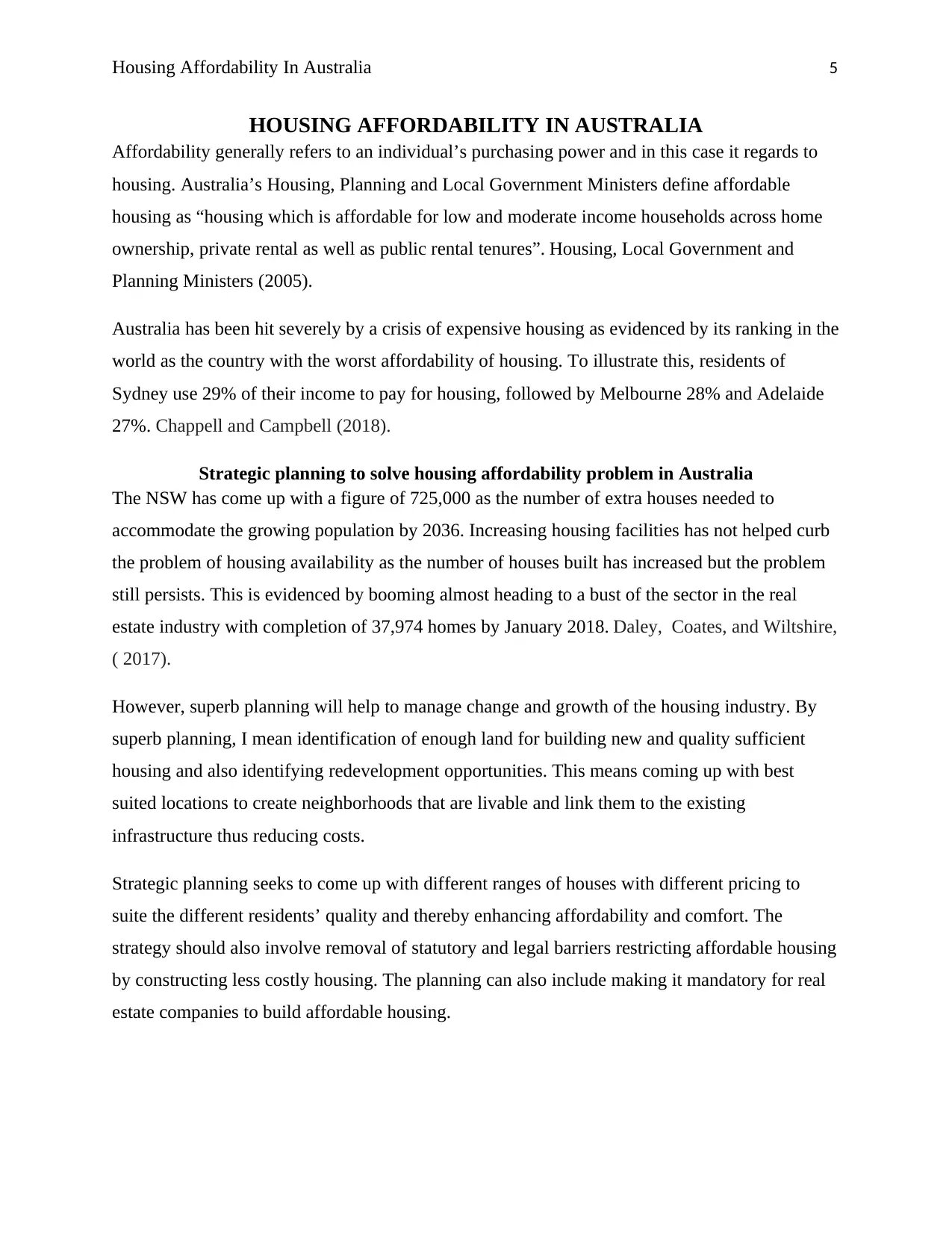
Housing Affordability In Australia 5
HOUSING AFFORDABILITY IN AUSTRALIA
Affordability generally refers to an individual’s purchasing power and in this case it regards to
housing. Australia’s Housing, Planning and Local Government Ministers define affordable
housing as “housing which is affordable for low and moderate income households across home
ownership, private rental as well as public rental tenures”. Housing, Local Government and
Planning Ministers (2005).
Australia has been hit severely by a crisis of expensive housing as evidenced by its ranking in the
world as the country with the worst affordability of housing. To illustrate this, residents of
Sydney use 29% of their income to pay for housing, followed by Melbourne 28% and Adelaide
27%. Chappell and Campbell (2018).
Strategic planning to solve housing affordability problem in Australia
The NSW has come up with a figure of 725,000 as the number of extra houses needed to
accommodate the growing population by 2036. Increasing housing facilities has not helped curb
the problem of housing availability as the number of houses built has increased but the problem
still persists. This is evidenced by booming almost heading to a bust of the sector in the real
estate industry with completion of 37,974 homes by January 2018. Daley, Coates, and Wiltshire,
( 2017).
However, superb planning will help to manage change and growth of the housing industry. By
superb planning, I mean identification of enough land for building new and quality sufficient
housing and also identifying redevelopment opportunities. This means coming up with best
suited locations to create neighborhoods that are livable and link them to the existing
infrastructure thus reducing costs.
Strategic planning seeks to come up with different ranges of houses with different pricing to
suite the different residents’ quality and thereby enhancing affordability and comfort. The
strategy should also involve removal of statutory and legal barriers restricting affordable housing
by constructing less costly housing. The planning can also include making it mandatory for real
estate companies to build affordable housing.
HOUSING AFFORDABILITY IN AUSTRALIA
Affordability generally refers to an individual’s purchasing power and in this case it regards to
housing. Australia’s Housing, Planning and Local Government Ministers define affordable
housing as “housing which is affordable for low and moderate income households across home
ownership, private rental as well as public rental tenures”. Housing, Local Government and
Planning Ministers (2005).
Australia has been hit severely by a crisis of expensive housing as evidenced by its ranking in the
world as the country with the worst affordability of housing. To illustrate this, residents of
Sydney use 29% of their income to pay for housing, followed by Melbourne 28% and Adelaide
27%. Chappell and Campbell (2018).
Strategic planning to solve housing affordability problem in Australia
The NSW has come up with a figure of 725,000 as the number of extra houses needed to
accommodate the growing population by 2036. Increasing housing facilities has not helped curb
the problem of housing availability as the number of houses built has increased but the problem
still persists. This is evidenced by booming almost heading to a bust of the sector in the real
estate industry with completion of 37,974 homes by January 2018. Daley, Coates, and Wiltshire,
( 2017).
However, superb planning will help to manage change and growth of the housing industry. By
superb planning, I mean identification of enough land for building new and quality sufficient
housing and also identifying redevelopment opportunities. This means coming up with best
suited locations to create neighborhoods that are livable and link them to the existing
infrastructure thus reducing costs.
Strategic planning seeks to come up with different ranges of houses with different pricing to
suite the different residents’ quality and thereby enhancing affordability and comfort. The
strategy should also involve removal of statutory and legal barriers restricting affordable housing
by constructing less costly housing. The planning can also include making it mandatory for real
estate companies to build affordable housing.
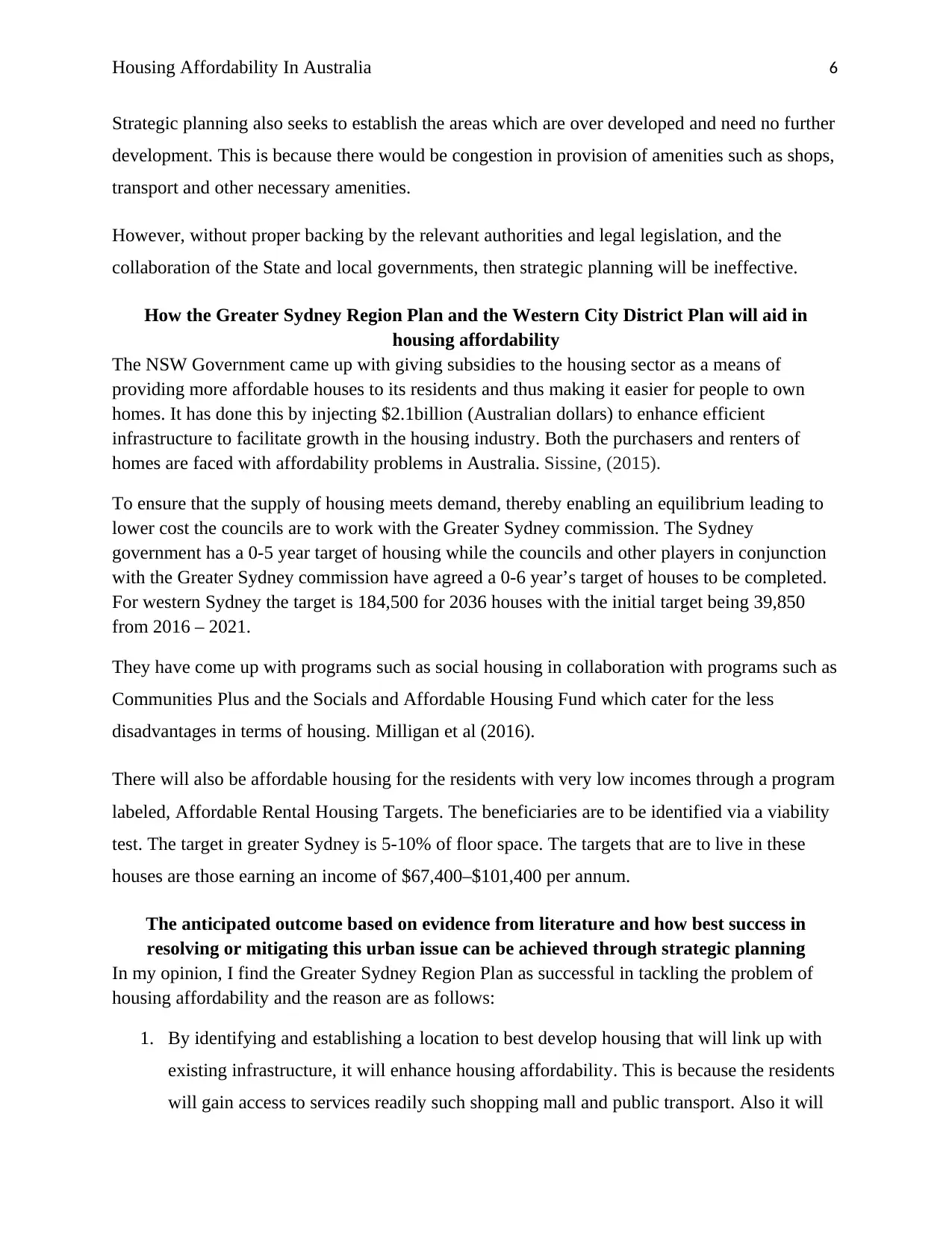
Housing Affordability In Australia 6
Strategic planning also seeks to establish the areas which are over developed and need no further
development. This is because there would be congestion in provision of amenities such as shops,
transport and other necessary amenities.
However, without proper backing by the relevant authorities and legal legislation, and the
collaboration of the State and local governments, then strategic planning will be ineffective.
How the Greater Sydney Region Plan and the Western City District Plan will aid in
housing affordability
The NSW Government came up with giving subsidies to the housing sector as a means of
providing more affordable houses to its residents and thus making it easier for people to own
homes. It has done this by injecting $2.1billion (Australian dollars) to enhance efficient
infrastructure to facilitate growth in the housing industry. Both the purchasers and renters of
homes are faced with affordability problems in Australia. Sissine, (2015).
To ensure that the supply of housing meets demand, thereby enabling an equilibrium leading to
lower cost the councils are to work with the Greater Sydney commission. The Sydney
government has a 0-5 year target of housing while the councils and other players in conjunction
with the Greater Sydney commission have agreed a 0-6 year’s target of houses to be completed.
For western Sydney the target is 184,500 for 2036 houses with the initial target being 39,850
from 2016 – 2021.
They have come up with programs such as social housing in collaboration with programs such as
Communities Plus and the Socials and Affordable Housing Fund which cater for the less
disadvantages in terms of housing. Milligan et al (2016).
There will also be affordable housing for the residents with very low incomes through a program
labeled, Affordable Rental Housing Targets. The beneficiaries are to be identified via a viability
test. The target in greater Sydney is 5-10% of floor space. The targets that are to live in these
houses are those earning an income of $67,400–$101,400 per annum.
The anticipated outcome based on evidence from literature and how best success in
resolving or mitigating this urban issue can be achieved through strategic planning
In my opinion, I find the Greater Sydney Region Plan as successful in tackling the problem of
housing affordability and the reason are as follows:
1. By identifying and establishing a location to best develop housing that will link up with
existing infrastructure, it will enhance housing affordability. This is because the residents
will gain access to services readily such shopping mall and public transport. Also it will
Strategic planning also seeks to establish the areas which are over developed and need no further
development. This is because there would be congestion in provision of amenities such as shops,
transport and other necessary amenities.
However, without proper backing by the relevant authorities and legal legislation, and the
collaboration of the State and local governments, then strategic planning will be ineffective.
How the Greater Sydney Region Plan and the Western City District Plan will aid in
housing affordability
The NSW Government came up with giving subsidies to the housing sector as a means of
providing more affordable houses to its residents and thus making it easier for people to own
homes. It has done this by injecting $2.1billion (Australian dollars) to enhance efficient
infrastructure to facilitate growth in the housing industry. Both the purchasers and renters of
homes are faced with affordability problems in Australia. Sissine, (2015).
To ensure that the supply of housing meets demand, thereby enabling an equilibrium leading to
lower cost the councils are to work with the Greater Sydney commission. The Sydney
government has a 0-5 year target of housing while the councils and other players in conjunction
with the Greater Sydney commission have agreed a 0-6 year’s target of houses to be completed.
For western Sydney the target is 184,500 for 2036 houses with the initial target being 39,850
from 2016 – 2021.
They have come up with programs such as social housing in collaboration with programs such as
Communities Plus and the Socials and Affordable Housing Fund which cater for the less
disadvantages in terms of housing. Milligan et al (2016).
There will also be affordable housing for the residents with very low incomes through a program
labeled, Affordable Rental Housing Targets. The beneficiaries are to be identified via a viability
test. The target in greater Sydney is 5-10% of floor space. The targets that are to live in these
houses are those earning an income of $67,400–$101,400 per annum.
The anticipated outcome based on evidence from literature and how best success in
resolving or mitigating this urban issue can be achieved through strategic planning
In my opinion, I find the Greater Sydney Region Plan as successful in tackling the problem of
housing affordability and the reason are as follows:
1. By identifying and establishing a location to best develop housing that will link up with
existing infrastructure, it will enhance housing affordability. This is because the residents
will gain access to services readily such shopping mall and public transport. Also it will
⊘ This is a preview!⊘
Do you want full access?
Subscribe today to unlock all pages.

Trusted by 1+ million students worldwide

Housing Affordability In Australia 7
be easy to access the existing schools and health facilities and live closer to the working
places. This will ensure that the residents save and thus making housing more affordable.
2. Building of different ranges of houses will also aid in affordable housing. This is because
both the low income earners and also those with higher incomes will be catered for.
3. Strategies like subsidizing housing projects will reduce the cost of construction and that
of acquiring land. This will therefore make housing cheaper.
On the other hand, the Western City District Plan does not tackle the problem of housing
affordability. In fact, it escalates the problem. This is because it seeks to expand and create
new infrastructure which will create employment and thereby bring about migration to the
district for job seekers. This will have the adverse effect of increasing population which will
lead to a sharp increase in demand for housing. The WCDP has no plans or strategic planning
on providing affordable housing for both the employed and the job seekers.
How other cities are planning affordable housing
Denver city in Colorado is faced by the problem of affordable housing. in order to tackle this, it
has came up with measures in a bid to curb the problem such as it has been continually
purchasing land and building low cost houses which it then sells to the low income residents at
subsidized prices. To facilitate this, it sells the houses in small installments for a period of 10
years. Clarke, (2017).
London has set a floor percentage to private real estate developers to incorporate affordable
housing at 35% in their projects. This is compulsory and will go a long way to providing cheaper
houses for low income earners in London. Also, London seeks to come up with measures to
check on rogue landlords who exploit clients and banning agent letting fees. Marom and
Carmon, ( 2015).
The above measures taken by the two cities are very idealistic and can be used to bring down
cost of housing in Australia. Although, there must be legislative measures to be taken in order to
implement what London is seeking to do since in Australia there are no rule governing on
regulation of fees landlord charge or the use of letting agents who often exploit tenants by hefty
fees since they act as brokers.
be easy to access the existing schools and health facilities and live closer to the working
places. This will ensure that the residents save and thus making housing more affordable.
2. Building of different ranges of houses will also aid in affordable housing. This is because
both the low income earners and also those with higher incomes will be catered for.
3. Strategies like subsidizing housing projects will reduce the cost of construction and that
of acquiring land. This will therefore make housing cheaper.
On the other hand, the Western City District Plan does not tackle the problem of housing
affordability. In fact, it escalates the problem. This is because it seeks to expand and create
new infrastructure which will create employment and thereby bring about migration to the
district for job seekers. This will have the adverse effect of increasing population which will
lead to a sharp increase in demand for housing. The WCDP has no plans or strategic planning
on providing affordable housing for both the employed and the job seekers.
How other cities are planning affordable housing
Denver city in Colorado is faced by the problem of affordable housing. in order to tackle this, it
has came up with measures in a bid to curb the problem such as it has been continually
purchasing land and building low cost houses which it then sells to the low income residents at
subsidized prices. To facilitate this, it sells the houses in small installments for a period of 10
years. Clarke, (2017).
London has set a floor percentage to private real estate developers to incorporate affordable
housing at 35% in their projects. This is compulsory and will go a long way to providing cheaper
houses for low income earners in London. Also, London seeks to come up with measures to
check on rogue landlords who exploit clients and banning agent letting fees. Marom and
Carmon, ( 2015).
The above measures taken by the two cities are very idealistic and can be used to bring down
cost of housing in Australia. Although, there must be legislative measures to be taken in order to
implement what London is seeking to do since in Australia there are no rule governing on
regulation of fees landlord charge or the use of letting agents who often exploit tenants by hefty
fees since they act as brokers.
Paraphrase This Document
Need a fresh take? Get an instant paraphrase of this document with our AI Paraphraser
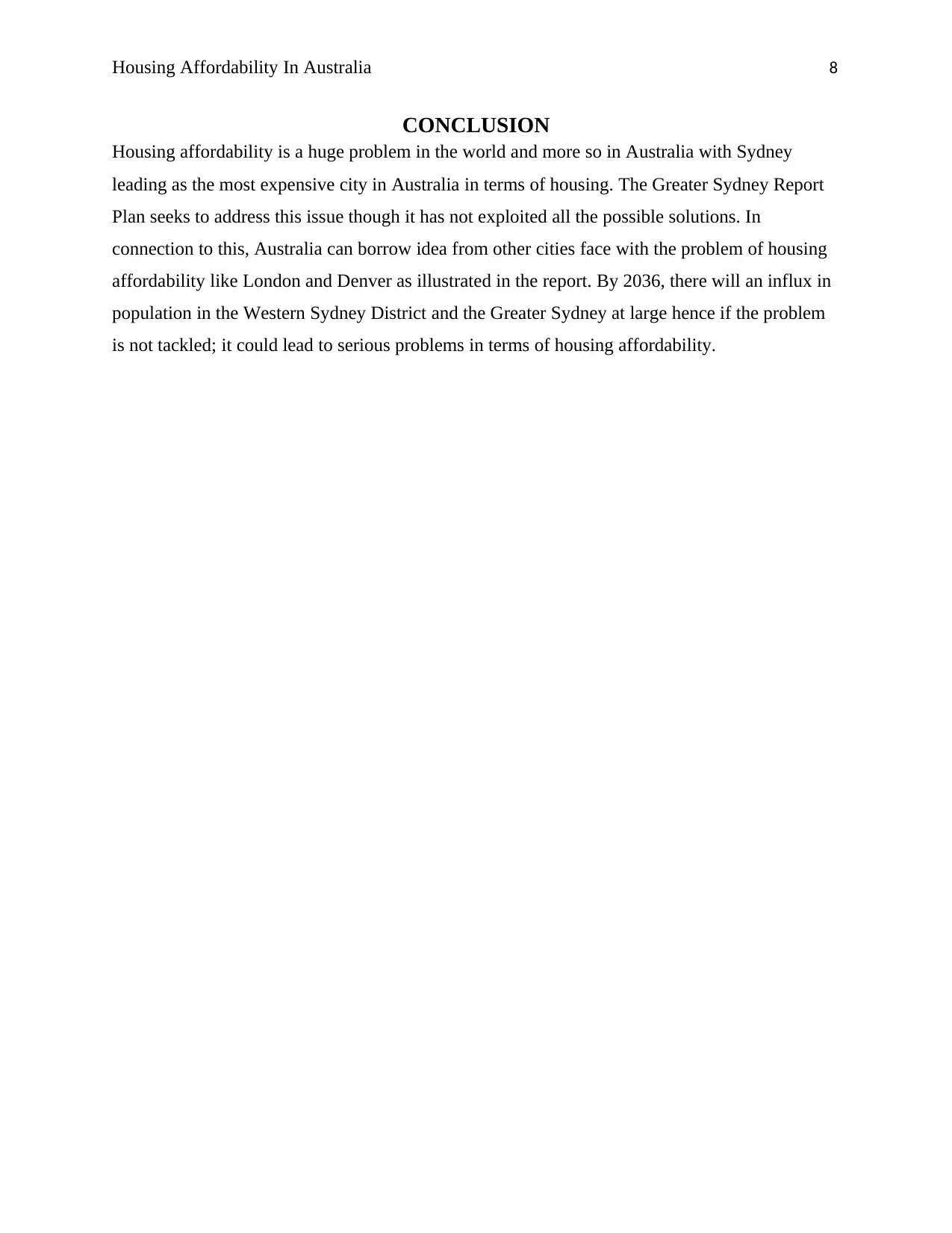
Housing Affordability In Australia 8
CONCLUSION
Housing affordability is a huge problem in the world and more so in Australia with Sydney
leading as the most expensive city in Australia in terms of housing. The Greater Sydney Report
Plan seeks to address this issue though it has not exploited all the possible solutions. In
connection to this, Australia can borrow idea from other cities face with the problem of housing
affordability like London and Denver as illustrated in the report. By 2036, there will an influx in
population in the Western Sydney District and the Greater Sydney at large hence if the problem
is not tackled; it could lead to serious problems in terms of housing affordability.
CONCLUSION
Housing affordability is a huge problem in the world and more so in Australia with Sydney
leading as the most expensive city in Australia in terms of housing. The Greater Sydney Report
Plan seeks to address this issue though it has not exploited all the possible solutions. In
connection to this, Australia can borrow idea from other cities face with the problem of housing
affordability like London and Denver as illustrated in the report. By 2036, there will an influx in
population in the Western Sydney District and the Greater Sydney at large hence if the problem
is not tackled; it could lead to serious problems in terms of housing affordability.
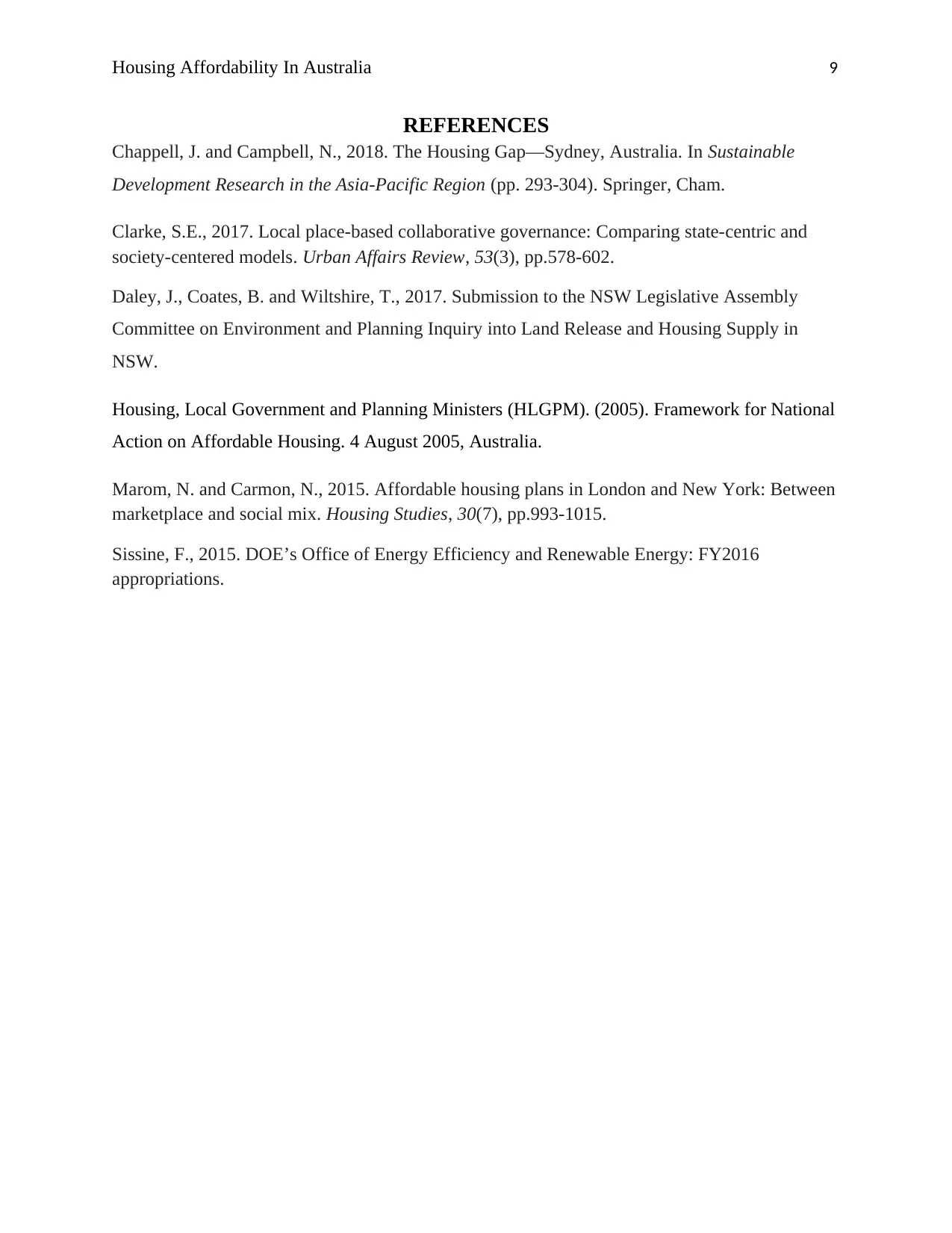
Housing Affordability In Australia 9
REFERENCES
Chappell, J. and Campbell, N., 2018. The Housing Gap—Sydney, Australia. In Sustainable
Development Research in the Asia-Pacific Region (pp. 293-304). Springer, Cham.
Clarke, S.E., 2017. Local place-based collaborative governance: Comparing state-centric and
society-centered models. Urban Affairs Review, 53(3), pp.578-602.
Daley, J., Coates, B. and Wiltshire, T., 2017. Submission to the NSW Legislative Assembly
Committee on Environment and Planning Inquiry into Land Release and Housing Supply in
NSW.
Housing, Local Government and Planning Ministers (HLGPM). (2005). Framework for National
Action on Affordable Housing. 4 August 2005, Australia.
Marom, N. and Carmon, N., 2015. Affordable housing plans in London and New York: Between
marketplace and social mix. Housing Studies, 30(7), pp.993-1015.
Sissine, F., 2015. DOE’s Office of Energy Efficiency and Renewable Energy: FY2016
appropriations.
REFERENCES
Chappell, J. and Campbell, N., 2018. The Housing Gap—Sydney, Australia. In Sustainable
Development Research in the Asia-Pacific Region (pp. 293-304). Springer, Cham.
Clarke, S.E., 2017. Local place-based collaborative governance: Comparing state-centric and
society-centered models. Urban Affairs Review, 53(3), pp.578-602.
Daley, J., Coates, B. and Wiltshire, T., 2017. Submission to the NSW Legislative Assembly
Committee on Environment and Planning Inquiry into Land Release and Housing Supply in
NSW.
Housing, Local Government and Planning Ministers (HLGPM). (2005). Framework for National
Action on Affordable Housing. 4 August 2005, Australia.
Marom, N. and Carmon, N., 2015. Affordable housing plans in London and New York: Between
marketplace and social mix. Housing Studies, 30(7), pp.993-1015.
Sissine, F., 2015. DOE’s Office of Energy Efficiency and Renewable Energy: FY2016
appropriations.
⊘ This is a preview!⊘
Do you want full access?
Subscribe today to unlock all pages.

Trusted by 1+ million students worldwide
1 out of 9
Related Documents
Your All-in-One AI-Powered Toolkit for Academic Success.
+13062052269
info@desklib.com
Available 24*7 on WhatsApp / Email
![[object Object]](/_next/static/media/star-bottom.7253800d.svg)
Unlock your academic potential
Copyright © 2020–2025 A2Z Services. All Rights Reserved. Developed and managed by ZUCOL.





